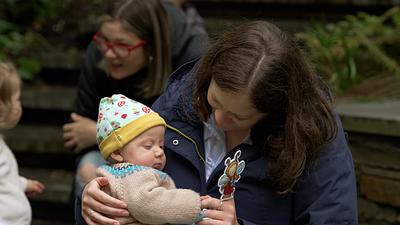Looking for all Articles by Early Years team?
The lasting legacy of a cuddle
New research highlights that cuddles not only comfort, soothe and calm a child, they’re also shaping genetics.

Emotional bonds
There is plenty of evidence that supports how important it is for babies to feel strong emotional bonds with their caregiver. Even before baby is born, both mother and child experience biological changes which facilitate bonding and attachment. It’s through experiencing loving interactions that babies are able to flourish and thrive, and to build the foundations for successful, long-term relationships throughout their lives. Through these loving interactions, babies are learning to regulate their emotions while they develop a sense of security and safety. This emotional safety is a key part of our emotional and physical development.
Cuddles shape genetics
The evidence for a baby's need for love has just got even stronger: research shows that cuddles not only comfort, soothe and calm a child, they’re also shaping genetics(this link will open in a new window). Babies who experience more cuddles and physical touch may experience genetic changes, especially in how their immune systems function, by affecting gene expression through mechanisms like DNA methylation. In the research study, children who received high levels of physical touch from their caregiver had a difference in two genes in comparison to children who received less touch – one related to immune system and one related to the metabolic system. The researchers highlight it’s not possible to tell from this study what the longer-term effects of these changes might be, but it’s amazing to think that something so simple as a quick cuddle can cause measurable biological changes.
Of course, there are plenty of other reasons to cuddle with your child. It can calm and soothe both baby and caregiver, help families stay connected and help children to feel safe and secure. The most important thing to remember, though, is to follow the lead of the child. Some children are naturally cuddly, and some children prefer that you show them love in other ways. It’s important to keep it positive for everyone - don’t force a cuddle if your child is not open to it.
Stories, songs, and cuddles
Songs, rhymes and stories are a great time to work an extra cuddle into your day. Take a few minutes, and chat about a book. Snuggle up and look at pictures together. As you hold your wee one, or they squash up next to you, make the most of this lovely close time together. If you’ve got a brave toddler who enjoys songs and rhymes, you can bounce them on your knee and tip them upside down (try Rickety Rickety Rockety Horse). The dangerous bit of going upside down is made okay – and even fun – when there is a big, reassuring cuddle at the end!
As you cuddle in for extra stories, songs or rhymes, remember that your physical touch can have a lasting impact on your child.